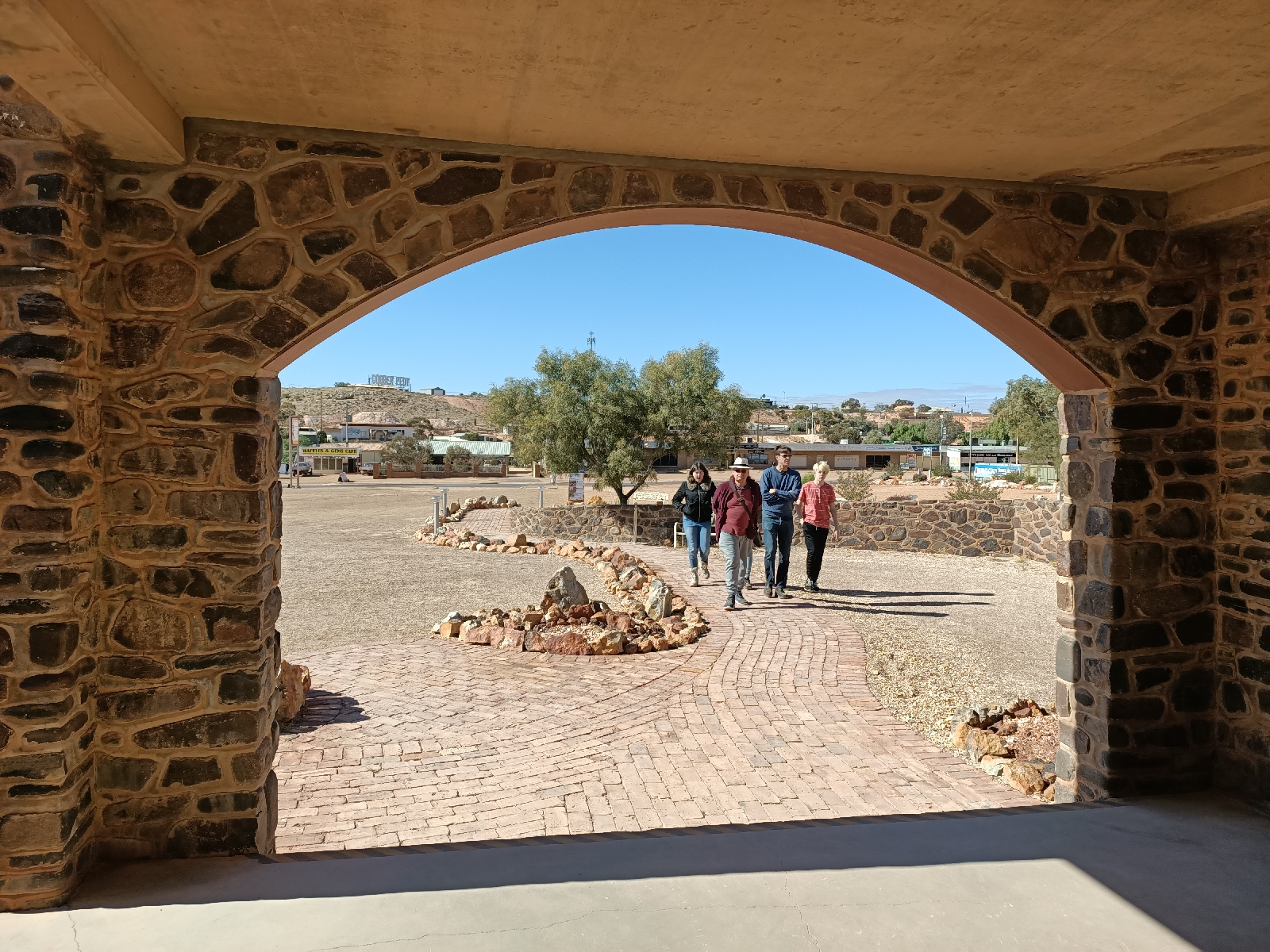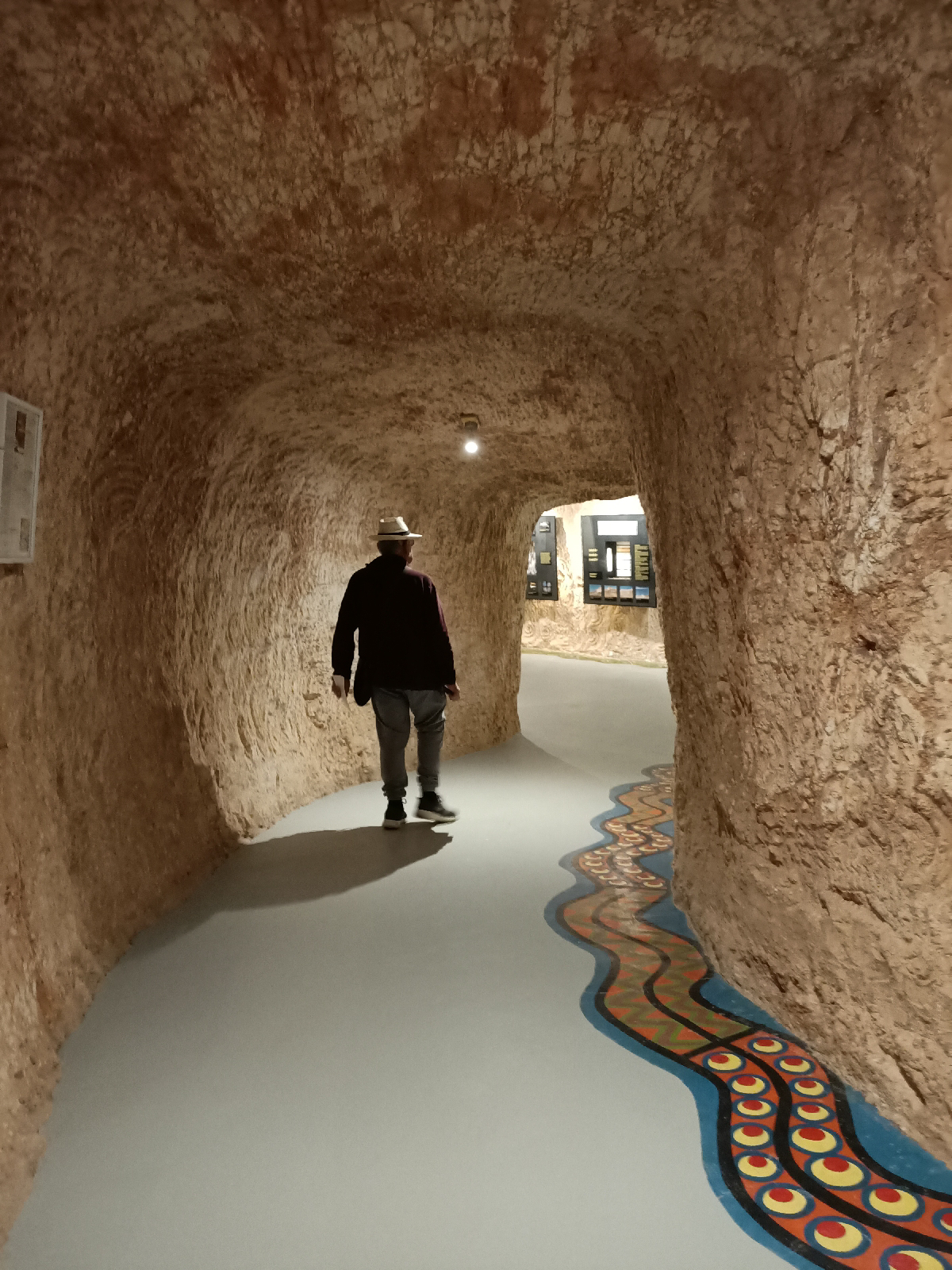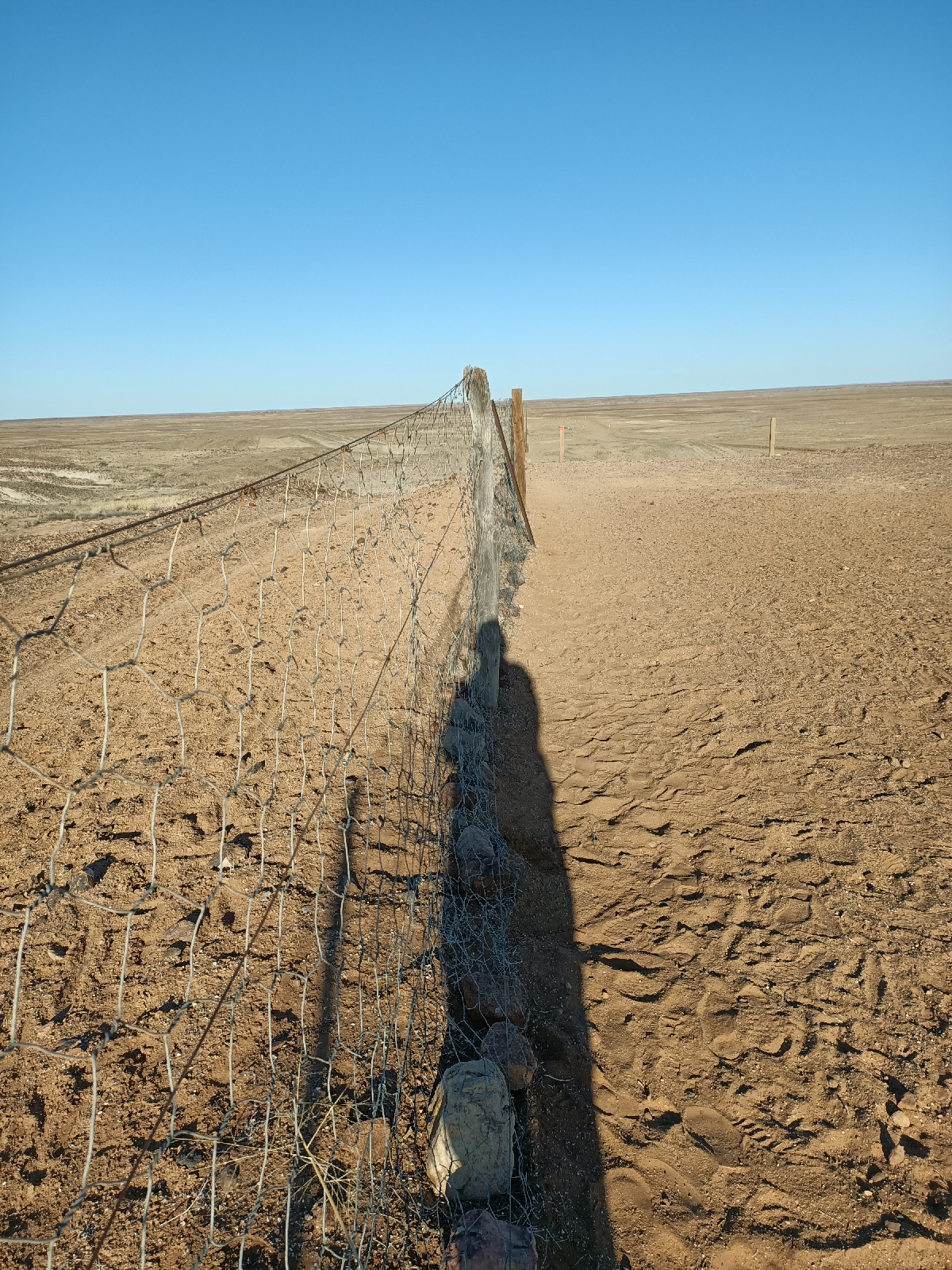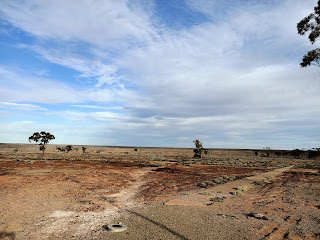Our first trip to the outback in South Australia, although when one looks at the map of Australia Coober Pedy is not really far away. However it was a 888 km and a 10 hour drive from Aldinga Beach, and we made an overnight stop driving there, and two stops coming back home. Interestingly people normally stop at Coober Pedy on the way north, to Alice Springs, Darwin or Uluru, or on a road trip elsewhere. We were often asked where we were going to after visiting Coober Pedy. But for us, this time, Coober Pedy was the destination.
And there was so much to see and do, along the way, and in Coober Pedy, we were very happy we made this relatively short trip.
As I have heaps of photographs I will blend our impressions and experiences in with the photos. My apologies as this turned out to be a very long blog.
We, Darren and three teenagers in one car, and us on our own in our larger vehicle, set off early in the morning. We carried all the extra bedding, mattresses plus tents in our car. Darren supervised Jay and Isabel, as learner drivers they were able to get plenty of driving experience.
As learner drivers, Jay and Isabel were only able to do 100 kmh in their car, and we were also only able to do 100 kmh as we were towing a caravan. So it was probably a slower trip than normal.
It was quite busy on the road to Port Augusta, but after that it was quiet. except for the road trains, plus a few cars and cars/caravans heading north to warmer places. The rest areas were deserted, and hardly any grey nomads and no young travellers or tourist buses.
Our first stop, for lunch, was at the park in Port Pirie. A delicious picnic lunch, organised by Darren, while looking out over the backwater. Not much of a view really A lovely park though. However, I think we will cross Port Pirie off as a place to visit, not very picturesque, although it was good to see that the shopping area looked prosperous.
A trifle cold too.
Finally Port Augusta, and a site with our own bathroom. A little bit of luxury, and appreciated as there were six of us in the group. For those people who have travelled with us in Europe, you will remember our 'spare room', the green Quechua tent, still going strong after eleven years.
We went for a walk down the main street, where there were many deserted buildings. I am not sure about the previous use of this closed up building, but it was a lovely old building.

The outside of the Serbian Church.
In the photograph below there is a part of machinery used for mining. I never did get my head around the machinery. And noodling? Noodles are small pieces of opal, which are missed when mining, and noodling is the process, either by hand or by machinery, by which people get the missed opals.
More hills and terrain, and lots of hidden shafts.
I have finally seen the beautiful flowers of the Sturt Desert Pea. Wow. I bought a packet of seeds and I aim to grow them here, in a pot in a sunny spot. Hopefully.
Darren crouching down as he read the information.
Hard work.
Miners climbed down the shafts using small holes in the walls. Not for me. Jespa looking on in amazement!
The family, who found the mine when they dug out a room to make a bedroom for their daughter, lived in this house from the late 1950s to 1990.
I have only visited Port Augusta once, somewhere in the mid 1980s, and I remember that I was impressed with the main street, with its brown pavers, trees and garden beds. Although the pavers are a little worn and dirty now, the trees and creepers have grown. It still looks very attractive, although many shops are now empty.
The wharf which would have been filled with cargo boats a hundred years ago. Port August is the point at which the Spencer Gulf ends, from here it is possible to drive west to Perth, or south to Port Lincoln on the other side of the gulf.
Walter and Darren discussing the landmarks Flinders Ranges is in the background of the photo.
A view across the inlet to the wharf where the previous photo was taken. We had drinks and dinner in the pub here, great food, and friendly service.
It took us a while to get going the next morning, due to packing up the two tents, and taking turns to have a shower in our private bathroom. Still there was no hurry really. Finally, with great anticipation of seeing the 'outback' at long last, we set forth up the Stuart Highway.
The first thing we noticed was the sunshine and no clouds. We had left in very overcast and cold weather. We travelled through mainly mallee country, so there was plenty of low growing bush around, but we did pass a few salt lakes, which were fascinating.
As I was driving my main occupation was passing the road trains, three trailers behind a heavy mover truck. Now that was scary at first. As we were towing a caravan, and the road trains were travelling at 90 to 100 kmh, I had to be sure that the road ahead was clear for a few kilometres. Walter kept an eye on the rear vision mirror and told me when to pull in again. Interestingly most of the road trains disappeared after our first stop, either they turned off for the mining town of Roxby Downs or they got ahead of us when we made our first stop.
Our first stop, in fact it was the first settlement, some 160 kms north of Port Augusta, called Pimba. A very dusty and barren place. Basically it was just a few buildings, plus a large roadhouse with motel rooms. And a camping ground, which cost a $5 donation to the local council.
The roadhouse was called an unlikely name, Spuds. Coffee was excellent, most important of course. The meals also looked pretty good too. And the people very friendly. The roadhouse doubled as a pub, offering 'happy hour' specials on a Friday (I think). I guess in normal times the camping ground would be full of travellers. On the days we passed through there was only one caravan.

Another 110 km up the road, passing nothing but scrubby bushes, sandy soil, and stones, we came to another settlement called Glendambo. We stopped there for lunch, another delicious feast organised by Darren. Altogether a very pleasant stop with clean toilets and picnic tables. And sunshine.
Finally onwards to Coober Pedy, 254 km away. Nothing in between, except for cattle grids and signs informing us of the properties we were passing through. The Woomera Range continued on our right.
The scenery was fascinating, as it had been since we left Port Augusta, and varied with the different vegetation, soil types and outcrops. We saw a few emus, plus cattle and sheep. Of course there were no fences so we saw plenty of roadkill, mainly kangaroos plus a few cattle. There were hundreds of birds of prey feasting on the carcasses, mainly black birds (not sure what they were) and wedge tailed eagles.
Sadly there were also hundreds of empty small plastic water bottles littering the roadside for about 50 kms north of Glendambo. Obviously people bought bottles of water at the road house there, and then threw them out of the car window when they finished. One wonders about some people's brains!
For the last few kilometres there were mounds of earth, and signs warning people about wandering off the road, and walking backwards to take photographs. Opal mines.
Finally in Coober Pedy. We went to our camping ground where we were given a place under the shade cloth, not needed at this time of year. It was always very dark in the caravan. Very good facilities and we had our own water tap, so could hook up to it. Water is a scarce and precious commodity so plenty of reminders about being careful with water
Darren rented a great unit, a budget one it said, but very clean and comfortable. Interestingly the windows and door had security bars on them. Crime is a bit of a problem in Coober Pedy apparently.
Our first trip out, to the excellent information centre, and then on to a flash hotel, with underground cafe, for coffee and wifi connection. After that our telephones pinged every time we drove past.
Walter and I had no telephone connection after we left Port Augusta, as our provider, Vodafone, does not have coverage outside of the coastal areas of Australia. Telstra and Optus were fine, so the rest of the family had good signals. We changed our provider as soon as we got back, to an Aldi sim card, and deal, which uses Telstra, and now we are saving dollars to get a better service. Luckily we were travelling with Darren.
Anyway back to being a tourist. There was a tunnel under the hotel, which had a comprehensive display of opal mining, opals, and general history of Coober Pedy. We followed the display from the end to the beginning due to our rush to get to the cafe, for coffee and wifi.
The main street of Coober Pedy.
The first thing we noticed was the lack of tourists. There were huge car parks, and no coaches, cars with caravans, motorhomes or anything really. Consequently it was very pleasant, with us and a few families visiting as it was school holidays. But very difficult for the local economy, who rely on the tourist trade. Not everyone mines opals.
We visited quite a few opal shops and displays on the first morning, but the one that impressed us most was the Umoona Opal Mine and Museum, opened in 1985. The Umoona (meaning the 'Tree of Life' Community was established to aid the settlement of indigenous people. Later on we drove through the settlement and there was an impressive amount of community ventures including mining for opals. Hopefully this was the case. One never knows.
The tunnels we visited had displays showing local history and land formation from when it was an icy inland sea (120 million years ago) to the present dry, harsh, flat landscape. There was an interesting fossil display room plus a huge opal shop, and sadly no customers.
Walter following the underground path.
Darren, Jay and Jespa pose for a photograph on the roof of the museum. A desolate country side.
Later in the afternoon we drove to the Kanku - Breakaways Conservation Park which comprised of approximately 140 sq kms of beautiful escarpments, hills and plains. The park is owned by the local Aboriginal Corporation, who are the traditional owners. The best times to visit are at dawn or dusk, so we opted to visit at sunset, too early to get up for the dawn views.
It is a circular drive, a 70 km round trip, and the look out points are roughly half way along the road. We first travelled along the corrugated gravel road (direction Oodnadatta), then turned off onto a dirt road, which was relatively smooth compared to the gravel.
The only problem was travelling in the dust from Darren's car! Flat country everywhere.
A photograph of the 2m high dog fence stretching out into the limitless horizon. This fence stretches for more than 5,300 kms across three states, to protect the sheep country in the south from the native dog, the Dingo. There was quite a lot of gypsum here which sparkled in the sun light.
The escarpments and hills were quite an amazing sight, so full of ever changing colour. It was a photographers' dream, however I only managed to get one decent photograph. Such a beautiful area though.
It was bitterly cold, but we managed to have a few drinks, plus cheese and nibbles. I had to wrap myself in a blanket to keep warm. The rest of the family were hardy, but it was a definite hat, coat and gloves time of day.
Jespa and Isabel sitting in the shelter of the back boot as they watched the sunset.
The sun setting over the flat land. Quite magnificent.
Morte photographs. Jespa and Isabel.
Darren and Jay stayed at the look out as they wanted to see the full moon rising over the land, but Walter, Jespa, Isabel and I headed back to Coober Pedy in order to get dinner started. An easy journey back, along the dirt road with markers on each side to make sure the tourists do not drive off into the desert, and get stuck in the sand.
The European history of Coober Pedy was not that long. The indigenous people (Anangu) have lived there for thousands of years, but the first european settlers did not arrive until 1858, and opals were only discovered in 1915. The early miners dug their shafts with basic tools: pick, shovel, knife, pliers, a hand windlass and bucket. Hard work. in the 1960s opal mining became mechanized, and modern machinery now includes blowers, elevators, bulldozers, tunnelling machines and noodling machines. 75% of the world's commercial opals are now mined in Coober Pedy.
We completed a tour of the underground churches. Fascinating.
The Serbian Orthodox Church had a beautiful vaulted ceiling, plus many statues, all carved out of the stone.The outside of the Serbian Church.
The inside of the Catholic Church.
Coober Pedy is quite desolate, with a harsh and very dry terrain. There are hills and open shafts everywhere, and signs warning not to stray from paths and road as there is a high chance of falling down an old shaft.
A dusty road in the suburbs. There are houses here, mostly set back from the road, and underground. Plus lots of mines.
A large proportion of the houses are underground, with just the front rooms in the open. The houses are warm in the winter and cool in the summer. Coober Pedy is well known for its underground houses.
The only evidence of the underground houses are the pipes for ventilation which pop up out of the ground at various intervals.There was also very little greenery around as it rarely rains, although we noticed Bougainvillea grows well here,.
This house was for sale. Anyone interested?
There was quite a bit of old machinery and cars lying about plus bits of houses everywhere. A very casual approach.In the photograph below there is a part of machinery used for mining. I never did get my head around the machinery. And noodling? Noodles are small pieces of opal, which are missed when mining, and noodling is the process, either by hand or by machinery, by which people get the missed opals.
An old bus with a piece of machinery. Part of a display in a mine museum, closed due to Covid-19.
I have never watched these movies but this large sculpture was used in the Mad Max movies.More hills and terrain, and lots of hidden shafts.
I have finally seen the beautiful flowers of the Sturt Desert Pea. Wow. I bought a packet of seeds and I aim to grow them here, in a pot in a sunny spot. Hopefully.
The Old Timers Mine. This mine dated back to 1916 but was never fully dug out. Apparently there were still opals there when it was accidentally discovered after an underground home extension broke though the wall.
It was a fascinating self guided tour through the old mine, but tall people like us had to bend double to walk through the tunnels.Darren crouching down as he read the information.
Hard work.
Miners climbed down the shafts using small holes in the walls. Not for me. Jespa looking on in amazement!
A miner asleep in his dugout.
The Post Office.The family, who found the mine when they dug out a room to make a bedroom for their daughter, lived in this house from the late 1950s to 1990.
The kitchen.
Bedroom/living room
Bathroom.
After three very interesting days we set off to return south. Our caravan and cars were full of red dust, and we all looked like we had been crawling through the dirt. But we were happy and contented with our stay in Coober Pedy.
Bedroom/living room
Bathroom.
I forgot to mention how good the food was in Coober Pedy, and the coffee. There was an excellent bakery. We ate pizzas at a restaurant that claimed to be one of the best in Australia, and they were very tasty. I bought an aboriginal painting, done by a local woman, and I hope that she was paid well for it. It was in old shop, run by a very deaf man, who unearthed all his paintings from underneath the counter. The trouble is one never knows if aboriginal artists get a fair deal. It is a lovely painting though. Although we looked at thousands of opals we did not purchase one. They were very expensive.
It was an easy trip back. The only problem was that my phone had had an update via the excellent wifi service at the camping ground, and it had changed the time to eastern Australia. Unknowingly I did not realise this and thought we were running half an hour behind the time we said we were leaving. It was not until I suggested we have lunch at Glendambo, and everyone said it was too early, that I realised my watch (connected to the telephone) was half an hour ahead. This threw my body clock out completely. Half an hour! No wonder it was so dark when we got up that morning.
We stopped in Woomera, which was 6 km from Pimbo.
The Woomera Traveller's Village and Caravan Park, was very run down, made worse by the surly manager. We got into trouble for driving through to our site instead of reversing into it. We stayed hooked up for a quick getaway the next morning. The rest of the family stayed in a cabin, a bit run down but comfortable and warm.
Woomera is now an RAAF Base and has been since 2015. The range covers a huge area, nearly all the way to Coober Pedy. It was established in 1947, together with Britain and a few other countries, in order to test missiles. Nuclear tests were carried out in the desert. A community town was built to serve the people working there, and by 1960 it held a population of over 5000 people. It was a closed community until about 1983, and only people who lived there could enter the township. In about 1982 the missile range was closed, and the town was opened up. Now there are only 120 people living there. A ghost town.
Woomera is now an RAAF Base and has been since 2015. The range covers a huge area, nearly all the way to Coober Pedy. It was established in 1947, together with Britain and a few other countries, in order to test missiles. Nuclear tests were carried out in the desert. A community town was built to serve the people working there, and by 1960 it held a population of over 5000 people. It was a closed community until about 1983, and only people who lived there could enter the township. In about 1982 the missile range was closed, and the town was opened up. Now there are only 120 people living there. A ghost town.
We walked into the centre of the town to see the museums, one of them turned out to be closed, as it was after 3 p.m, and the other museum was being renovated. This was disappointing but we intend to go back there one day.
We looked at the planes.
And went for a walk. Green grass.
It was strange to walk around the deserted town, all beautifully laid out with footpaths, bus stops and empty houses. We could see the original irrigation systems running along the edge of the road, and in the gardens of the houses. Nothing was working now so all we could see was sand and dead trees.
And went for a walk. Green grass.
It was strange to walk around the deserted town, all beautifully laid out with footpaths, bus stops and empty houses. We could see the original irrigation systems running along the edge of the road, and in the gardens of the houses. Nothing was working now so all we could see was sand and dead trees.
A view into the desert, but there was a road there, and light posts. No doubt there was an intention to build more houses in this area.
Excellent footpaths and street lighting but no one around, but us.
Excellent footpaths and street lighting but no one around, but us.
Deserted houses. Very ghostly.
That night Darren cooked our meat feast (chops, sausages, chicken) . As the barbeque was roped off due to Covid-19 Darren had to use the grill and frying pans. We think the manager was too lazy to keep the barbeque area clean. It was all delicious.
We left early the next morning and headed to Port Augusta, where we said goodbye to Darren, Jay, Jespa and Isabel. They were driving directly to Adelaide. We drove across the hills to the lower Flinders where we met a number of cars and campers loaded with mountain bikes. As it was school holidays people were heading to the Flinders Ranges for a holiday, as they could not go skiing in Victoria or travel to Bali, another popular July holiday destination. We stopped in Clare, and the camping ground was full, which was a bit scary as social distancing was impossible.
It rained all night, and continued to do so until we got home, where it rained even heavier as we backed the caravan onto the paving. Walter reversed the caravan, and I directed, and it took ages as Walter could not see due to the mirrors being so wet, and I kept having to jump about to keep out of his way. Our only major mishap occurred at this point. One of the plastic ramps shot out from under the wheel and hit me on the foot. Luckily I had strong leather boots on, but I have a black toenail to prove that it happened. I was also shedding down feathers from a rip in my jacket. I think I ripped it as I was putting the ramps under the wheels. It was not one of our best moments.
It was a great trip, so many lovely memories, and an extra bonus of spending family time with Darren, Jay, Jespa and Isabel.

















































